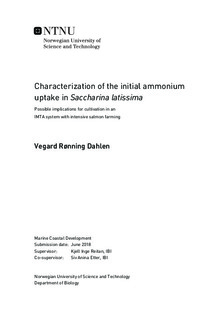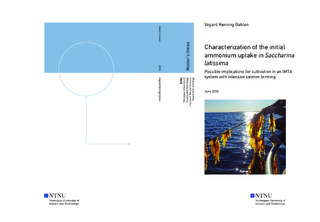| dc.description.abstract | Production of Atlantic salmon (Salmo salar) results in a release of ca. 39% of the total nitrogen content from the feed, which is mainly released as dissolved inorganic nitrogen (DIN), and mainly as the metabolic by product NH4+. At the same time, the most frequently limiting nutrient for macroalgae growth is DIN. Cultivation of the commercially attractive species Saccharina latissima in an integrated multi-trophic aquaculture system (IMTA) with intensive salmon farming, is therefore a suggested approach to increase the long-term sustainability of the aquaculture sector through bioremediation of released nutrients.
The aim of this thesis was to characterize the NH4+ uptake in S. latissima in a IMTA system. Two main studies were conducted: a control study to determine the uptake of NH4+ as the only available nitrogen source, and a preference study to investigate any interaction between effluent NH4+ and naturally occurring NO3-. Uptake was measured in a controlled laboratory experiment combining the commonly used multiple flask and perturbation methods. S. latissima of different nutritional histories were exposed to a gradient of NH4+ ranging between 0.25-16 µM, with and without 1 µM of NO3- available, over a 5-hour period. By following the depletion of substrate concentration, uptake rates (µM gDW-1 h-1) of these pulsed availabilities were determined.
S. latissima appeared to efficiently adapt to new and different availabilities of NH4+, demonstrating rapid increases in uptake rates toward maximal rate, which was always observed within 50 minutes. Furthermore, the NH4+ uptake increased linearly with increased availability up to 16 µM, regardless of nutritional history and available nitrogen source. The rate of removal was the highest when NH4+ was the only available nitrogen source. The nutritional history of the S. latissima also appeared to affect the uptake, and nitrogen deficient specimens demonstrated a faster uptake of NH4+ than nitrogen sufficient specimens, with several significant differences. Upon exposure to new conditions, S. latissima demonstrated a brief initial induction period before uptake was evident. A consistent uptake of NO3- only appeared after a lag period of approximately 50 minutes, demonstrated a preferential uptake of the energetically favourable NH4+. When NO3- was available, the nutritional history appeared to have a smaller effect on uptake of both NO3- and NH4+, as there were observed relatively few and inconsistent significant differences between the samples with sufficient and deficient specimens. | en |

